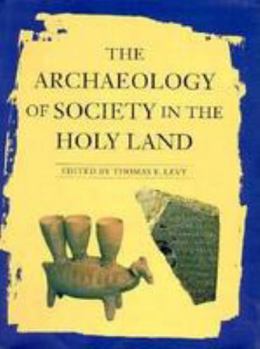The Archaeology of Society in the Holy Land
Select Format
Select Condition 
Book Overview
The Archaeology of Society in the Holy Land tackles difficult questions about the region by introducing new historical, anthropological, and socioeconomic perspectives.Chronologically organized... This description may be from another edition of this product.
Format:Hardcover
Language:English
ISBN:0816028559
ISBN13:9780816028559
Release Date:January 1984
Publisher:Facts on File
Length:624 Pages
Weight:3.60 lbs.
Dimensions:1.4" x 7.9" x 10.2"
Customer Reviews
1 rating
A Survey of Archæological Evidence Reaching Far in the Past
Published by Thriftbooks.com User , 24 years ago
Archæology constitutes a meticulous study of ancient artifacts and residues from periods in human history remote to the modern world. This field of anthropology is marked by differences in emphasis, depending on the region under excavation. In the southern Levant, such focus generally accentuates what has been termed "biblical archæology", designed to augment historical understanding of the scriptures, both the Hebrew Canon and the New Testament. Aside from difficulties inherent in synthsizing descriptions written or edited centuries after the events narrated, often with religious revelations overriding historical "accuracy" (a concept whose importance has been presumed only relatively recently), archæology--being predominantly a material discipline--can interpret only what is physically observable in the present. Recent decades have witnessed profound changes in archæology, expanding beyond the evidence of technological advancement--from Paleolithic hunter-gatherers to Neolithic agriculturists to the Bronze and Iron ages--as well as political demarcations--Canaanite city states, Isrælite monarchies, hegemonies under Persian, Roman or Ottoman rule. Social archæology--intended to examine the culture of the region in question--is the theme in _The_Archæology_of_Society_in_the_Holy_Land_, edited by Thomas E. Levy, professor of Judaic Studies at the University of California, San Diego. The articles cover a wide chronology from the early Paleolithic age to the modern era in terms of material culture, as well as flora, fauna, climate, economy, and manufacture. To preclude an overly narrow focus on Biblical periods, the thirty authors devote over a third of the book to the premetal times. Most of the dates are given in BCE and CE (which I do not appreciate, preferring the more traditional BC and AD), except the prehistoric periods which are rendered BP [before present]. The text is profusely illustrated, not only with photographs of pottery and plaques, but replete with detailed diagrams of excavated sites and shaded relief maps depicting these locations. This collective endeavor has been dedicated to the spirit of Fernand Braudel, the French historian who developed the theory of longue durée or long duration undercurrents which (allegedly) act independently of individual activities for any given span. Although this suggests a somewhat Tolstoyan conceit, the analysis presented renders support to people being influenced by the conditions in which they live. _The_Archæology_of_Society_ begins with a preface describing its interdisciplinary approach weaving anthropology (the study of culture), history (textual criticism of ancient records), geoscience (including climatology and geology), archeometry (artifacts dating, materials identification), and environmental archæology (encompassing botany and zoology). The six parts that follow are further subdivided chronologically into 32 chapters. The climate in






